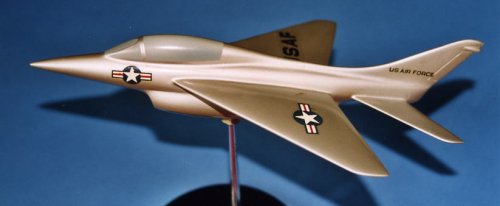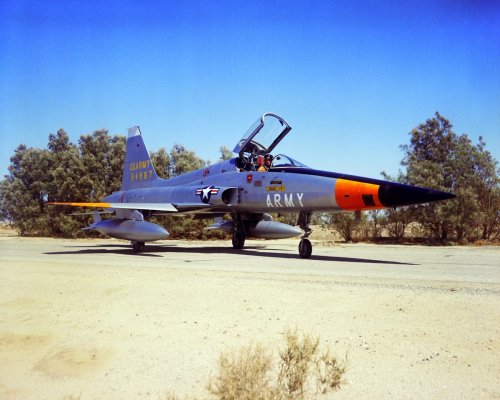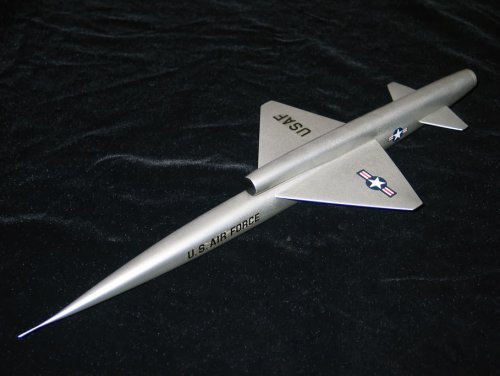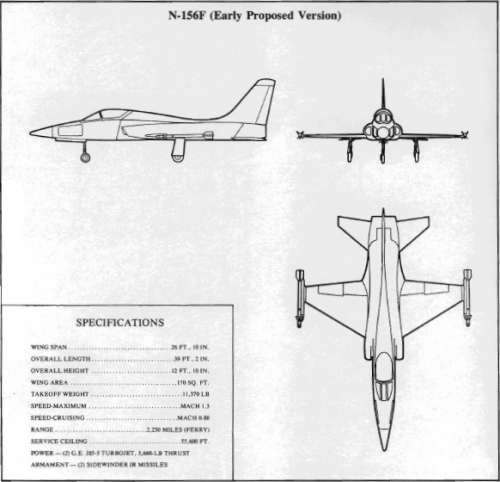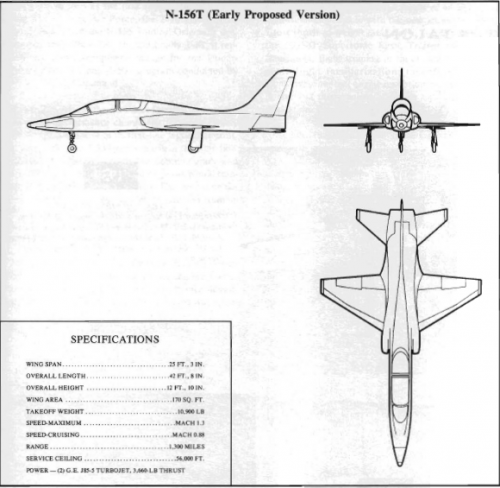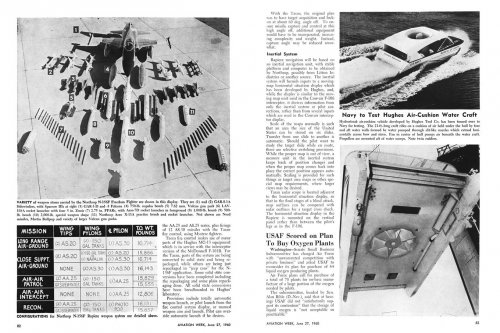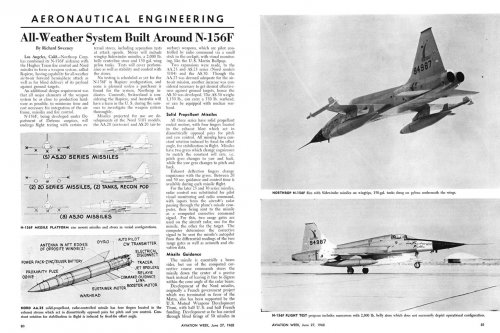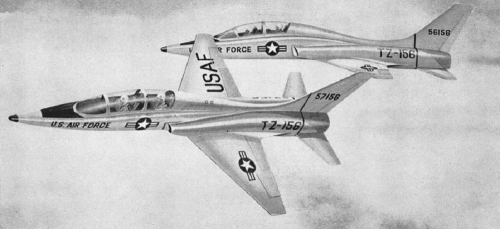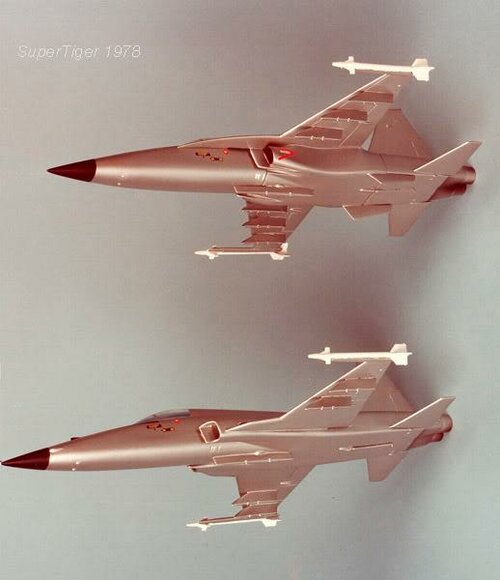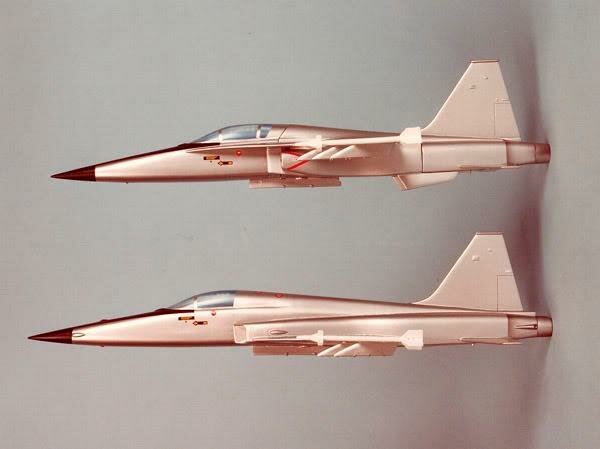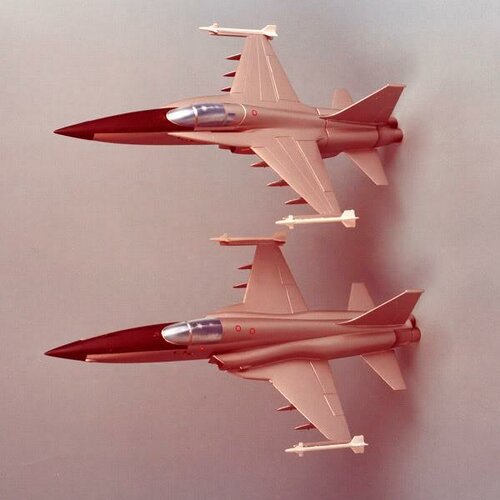You are using an out of date browser. It may not display this or other websites correctly.
You should upgrade or use an alternative browser.
You should upgrade or use an alternative browser.
N-156: Evolution of the Northrop F-5
- Joined
- 25 June 2009
- Messages
- 14,732
- Reaction score
- 6,070
hesham said:My dear Arjen,
the source for CL-457 is Mr. Tony Butler's book; American Secret Projects: Fighters & Interceptors 1945-1978.
No-one disputed the suggestion of the CL-457. It is your suggestion of the F-108 Rapier in this context that makes absolutely no sense. The F-108 was a much bigger type of aircraft with completely different missions. It was designed as an escort fighter for the B-70 Valkyrie and nothing else!
- Joined
- 26 May 2006
- Messages
- 34,828
- Reaction score
- 15,709
Stargazer,
the Lockheed CL-457 is one of F-X contenders as Mr Tony Butler's book,but the North
American Rapier is a single-seat lightweight fighter with delta wing and chin intake,
and not related to F-108 Rapier,the last one only which I suggested.
the Lockheed CL-457 is one of F-X contenders as Mr Tony Butler's book,but the North
American Rapier is a single-seat lightweight fighter with delta wing and chin intake,
and not related to F-108 Rapier,the last one only which I suggested.
- Joined
- 26 May 2006
- Messages
- 34,828
- Reaction score
- 15,709
Yes my dear Arjen,
and do you remember this topic;
http://www.secretprojects.co.uk/forum/index.php/topic,3870.msg30319.html#msg30319
and do you remember this topic;
http://www.secretprojects.co.uk/forum/index.php/topic,3870.msg30319.html#msg30319
Attachments
- Joined
- 6 November 2010
- Messages
- 5,251
- Reaction score
- 5,480
well, it completely slipped my mind. Thank you for reminding mehesham said:and do you remember this topic;
http://www.secretprojects.co.uk/forum/index.php/topic,3870.msg30319.html#msg30319
Steve Pace
Aviation History Writer
- Joined
- 6 January 2013
- Messages
- 2,266
- Reaction score
- 225
I disagree - the F-108 was to be an area- and point-defense all-missile-armed interceptor to kill incoming Soviet bombers. -SPStargazer2006 said:hesham said:My dear Arjen,
the source for CL-457 is Mr. Tony Butler's book; American Secret Projects: Fighters & Interceptors 1945-1978.
No-one disputed the suggestion of the CL-457. It is your suggestion of the F-108 Rapier in this context that makes absolutely no sense. The F-108 was a much bigger type of aircraft with completely different missions. It was designed as an escort fighter for the B-70 Valkyrie and nothing else!
- Joined
- 22 January 2006
- Messages
- 4,206
- Reaction score
- 2,001
Dear gentlemen,
About the XF-108
Opening American Secret Projects at page 112 can read that North American NA-257/XF-108 Rapier was designed to LRI (Long Range Interceptor) competition. As Mr Pace said it was an aircraft designed to defend US cities from incoming Soviet bombers.
Never found, at credible sources, suggestions to use it as the XB-70 escort fighter.
F-108 submitted to the first F-X?. Never read about that. That's an hypothesis?. It's illogical, F-108 and F-5 can't be compared in any sense.
Now going back to the topic
A brief description of Northrop N-156, N-156F and N-156T is offered at American Secret Projects page 186 and 187 but a lot of info can be found at Aerograph I General Dynamics F-16 Fighting Falcon by Jay Miller
Page 7:
No US competition here
In the same time Lockheed was designing, developing and selling F-104 variants to foreign customers. According to American Secret Projects, page 230, Lockheed CL-457 could have been Lockheed's entry in the Mutual Assistance Program competing with the Northrop F-5A
According to Jay Miller's book, Lockheed developed an F-104 derivative with the designation CL-985 to compete with Northrop for future foreign contracts.
Northrop contemporary studies for F-5A replacement resulted in the F-5E and later, in the Cobra.
Page 8
About the XF-108
Opening American Secret Projects at page 112 can read that North American NA-257/XF-108 Rapier was designed to LRI (Long Range Interceptor) competition. As Mr Pace said it was an aircraft designed to defend US cities from incoming Soviet bombers.
Never found, at credible sources, suggestions to use it as the XB-70 escort fighter.
F-108 submitted to the first F-X?. Never read about that. That's an hypothesis?. It's illogical, F-108 and F-5 can't be compared in any sense.
Now going back to the topic
A brief description of Northrop N-156, N-156F and N-156T is offered at American Secret Projects page 186 and 187 but a lot of info can be found at Aerograph I General Dynamics F-16 Fighting Falcon by Jay Miller
Page 7:
In funding the F-5 program, the DoD had committed itself to the idea of developing a simple, inexpensive, but reasonably capable fighter which could be sold to countries which could not afford or operate more complex types
No US competition here
In the same time Lockheed was designing, developing and selling F-104 variants to foreign customers. According to American Secret Projects, page 230, Lockheed CL-457 could have been Lockheed's entry in the Mutual Assistance Program competing with the Northrop F-5A
Once Lockheed and Northrop concluded that there would definitely be a need for an F-104 and/or F-5A replacement, the two companies began pumping in-house funding into design studies that, it was hoped, would create the winning airplane
According to Jay Miller's book, Lockheed developed an F-104 derivative with the designation CL-985 to compete with Northrop for future foreign contracts.
Northrop contemporary studies for F-5A replacement resulted in the F-5E and later, in the Cobra.
Page 8
While Northop and Lockheed involved in the creation of new fighters to sell to foreign customers, the AF under pressure from the OASD/SA, initiated a new fighter study known as the F-X that had the primary objective of bolstering AF tactical strength as rapidly and economically as possible. The Northrop F-5 and the Vought A-7, already in production, were presented by proponents as being suitable for filling the F-X role.
Following much debate and OSD pressure the AF opted for the A-7 in November 1965.
Although this decision was hailed in some circles as a victory for the ground attack and commonality advocates...it stablished the argument for developing a new, air superiority-oriented AF fighter.
The concept was also refered as F-X....The (new) F-X Concept Formulation Phase was initiated in December 1965 with the release to the aerospace industry of requests for parametric design studies
- Joined
- 22 January 2006
- Messages
- 4,206
- Reaction score
- 2,001
I don't know what's that info from wikipedia:
I want to research further on more reliable sources to clarify the F-5A original contract
In 1962, however, the Kennedy Administration revived the requirement for a low-cost export fighter, selecting the N-156F as winner of the F-X competition on 23 April 1962 subsequently becoming the "F-5A", being ordered into production in October that year.[14]
I want to research further on more reliable sources to clarify the F-5A original contract
- Joined
- 26 May 2006
- Messages
- 34,828
- Reaction score
- 15,709
My dear Pometablava,
I never said the F-108 Rapier was submitted to MAP competition,but I only suggested that,
the North American Rapier,which was a single seat delta wing lightweight fighter with intake
looks like F-16,this is my point,and the NA Rapier was not related anyway to F-108 Rapier.
And for second contest to replace F-5A,which called IFA,the tenders were Vought V.1000,
Lockheed CL-1200,McDonnell Dougals F-4EF and Northrop F-5 II.
I never said the F-108 Rapier was submitted to MAP competition,but I only suggested that,
the North American Rapier,which was a single seat delta wing lightweight fighter with intake
looks like F-16,this is my point,and the NA Rapier was not related anyway to F-108 Rapier.
And for second contest to replace F-5A,which called IFA,the tenders were Vought V.1000,
Lockheed CL-1200,McDonnell Dougals F-4EF and Northrop F-5 II.
- Joined
- 25 June 2009
- Messages
- 14,732
- Reaction score
- 6,070
First of all my apologies to hesham about the Rapier confusion. When you mentioned the NAA Rapier as a contender for the N-156, I didn't realize you were talking about the OTHER Rapier (which is the one that most people remember with that name).
As for my remark about "F-X" being the name of the F-15 Eagle (which is of course true), it appears that the acronym was reused from the much earlier program that spawned the N-156. This got me confused too...
You are right Steve. However I'm sure I read that the F-108, at some point of the Rapier program (possibly when the design was briefly revived in 1960), was to be an escort fighter for the Valkyrie. Was that completely wrong? Well obviously it wasn't in your Aero book, must have been elsewhere.
As for my remark about "F-X" being the name of the F-15 Eagle (which is of course true), it appears that the acronym was reused from the much earlier program that spawned the N-156. This got me confused too...
Steve Pace said:the F-108 was to be an area- and point-defense all-missile-armed interceptor to kill incoming Soviet bombers. -SP
You are right Steve. However I'm sure I read that the F-108, at some point of the Rapier program (possibly when the design was briefly revived in 1960), was to be an escort fighter for the Valkyrie. Was that completely wrong? Well obviously it wasn't in your Aero book, must have been elsewhere.
- Joined
- 27 December 2005
- Messages
- 17,712
- Reaction score
- 26,178
hesham said:Never mind my dear Stargazer,
and I hope to get a drawing to Lockheed CL-457,specially Mr. Tony Butler called
it F-104-9,and I search about any more info about it,but no way.
CL-457 was in essence just an F-104G with some equipment removed.
- Joined
- 27 December 2005
- Messages
- 17,712
- Reaction score
- 26,178
Stargazer2006 said:First of all my apologies to hesham about the Rapier confusion. When you mentioned the NAA Rapier as a contender for the N-156, I didn't realize you were talking about the OTHER Rapier (which is the one that most people remember with that name).
As for my remark about "F-X" being the name of the F-15 Eagle (which is of course true), it appears that the acronym was reused from the much earlier program that spawned the N-156. This got me confused too...
"F-X" in this context means "Fighter - [unknown number]" and was used at least three times.
- Joined
- 26 May 2006
- Messages
- 34,828
- Reaction score
- 15,709
PaulMM (Overscan) said:CL-457 was in essence just an F-104G with some equipment removed.
Thank you my dear Paul.
- Joined
- 12 October 2009
- Messages
- 557
- Reaction score
- 213
Attachments
- Joined
- 31 May 2009
- Messages
- 1,154
- Reaction score
- 665
tartle said:Not sure where to link this blog [...]
How about in "Interesting Websites": http://www.secretprojects.co.uk/forum/index.php/board,20.0.html
- Joined
- 26 May 2006
- Messages
- 34,828
- Reaction score
- 15,709
PaulMM (Overscan) said:N-156F with wingtip missiles.
Source:
Jerry Scutts: Modern Combat Aircraft 25 Northrop F-5/F-20, Ian Allan, 1986
My dear Paul,
here is the same drawing with data,and a drawing to N-156T early proposed.
Northrop an Aeronautical History
Attachments
- Joined
- 21 May 2006
- Messages
- 2,994
- Reaction score
- 2,259
Jemiba said:Proposal by Northrop of the N-156F as an all-weather system, using the Hughes Taran fire control
system and Nord Aviation missiles, designated "Rapiere", in the air-to-air role the AA.20 was envisaged,
for air-to-ground the AS.20 or AS.30.
(From Aviation Week June 1960, sorry for the low quality of the drawing, not much better in the article)
Don't mean to detract from principle N-156 topic, but found this:
Nord Aviation AA.20 ‘Rapiere’ air to air missile - was designated the Type 5103. The AA.20 missile project was always regarded as a stepping stone to a more advanced missile (which would materialise as the R.530.). The AA.20 was command guided, using a similar system to that used by Nord's SS.10 ATGM.
Regards
Pioneer
- Joined
- 28 November 2006
- Messages
- 711
- Reaction score
- 732
Besides N-156 (a fighter for USN's 'jeep carriers') and N-156A (trainer for USAF) Northrop worked upon an rocket-assisted interceptor: N-156R (it was intended for USN as well). That version carried a 5000-lb variable-thrust TR-132 turbo-rocket built by Reaction Motors in addition to two SJ110-B3s (later designated J85-GE-5). The only external difference was the protruding rocket exhaust nozzle (circle inset drawing in N-156.jpg).
N-156:
Length 34' 11''
Wingspan (incl. weapons pods) 26' 3''
2 x SJ110-B3/J85-GE-5 each 2470 lb dry, 3670 lb reheat
Max. speed 815 knots (Ma = 1.51) at 35,000 feet
Combat ceiling 62,100 feet
Armament: two Sidewinders in frangible wingtip pods or two wingtip pods each with 24 1.5-in Gimlet rockets
N-156A:
Length 36' 3''
Wingspan 24' 5''
2 x SJ110-B3/J85-GE-5 each 2470 lb dry, 3670 lb reheat
Max. speed Ma = 1.57 at 35,000 feet
Combat ceiling 61,400 feet
Armament two Sidewinders on wingtip launching rails
N-156R:
Length 34' 11''
Wingspan (incl. weapons pods) 26' 3''
2 x SJ110-B3/J85-GE-5 each 2470 lb dry, 3670 lb reheat
1 x TR-132 5000 lb rocket engine
Max. speed Ma = 2.0 at 35,000 feet to 78,500 feet
Combat ceiling 86,000 feet
Armament: as N-156
Source: 'Flying Wings & Radical Things: Northrop's Secret Aerospace Projects' by Anthony Chong
Piotr
N-156:
Length 34' 11''
Wingspan (incl. weapons pods) 26' 3''
2 x SJ110-B3/J85-GE-5 each 2470 lb dry, 3670 lb reheat
Max. speed 815 knots (Ma = 1.51) at 35,000 feet
Combat ceiling 62,100 feet
Armament: two Sidewinders in frangible wingtip pods or two wingtip pods each with 24 1.5-in Gimlet rockets
N-156A:
Length 36' 3''
Wingspan 24' 5''
2 x SJ110-B3/J85-GE-5 each 2470 lb dry, 3670 lb reheat
Max. speed Ma = 1.57 at 35,000 feet
Combat ceiling 61,400 feet
Armament two Sidewinders on wingtip launching rails
N-156R:
Length 34' 11''
Wingspan (incl. weapons pods) 26' 3''
2 x SJ110-B3/J85-GE-5 each 2470 lb dry, 3670 lb reheat
1 x TR-132 5000 lb rocket engine
Max. speed Ma = 2.0 at 35,000 feet to 78,500 feet
Combat ceiling 86,000 feet
Armament: as N-156
Source: 'Flying Wings & Radical Things: Northrop's Secret Aerospace Projects' by Anthony Chong
Piotr
- Joined
- 27 December 2005
- Messages
- 17,712
- Reaction score
- 26,178
Please don't post pictures from Tony Chong's book on this forum. Please buy the book if you want to see the drawings.
- Joined
- 28 November 2006
- Messages
- 711
- Reaction score
- 732
Actually the book on Northrop secret projects is available at Google Books (https://books.google.pl/books?id=BPw6DAAAQBAJ). It may be reviewed (lawfully and free of charge) but unfortunately it can't bought there as an e-book.
- Joined
- 27 December 2005
- Messages
- 17,712
- Reaction score
- 26,178
It can be bought as an ebook from Speciality Press directly, which is a high quality PDF. I own a copy, as it was much cheaper than getting the hard copy posted to me.
I have asked that people don't post images here out of respect for Tony Chong's hard work. By all means post references and page numbers however.
I have asked that people don't post images here out of respect for Tony Chong's hard work. By all means post references and page numbers however.
- Joined
- 28 November 2006
- Messages
- 711
- Reaction score
- 732
Jemiba said:Proposal by Northrop of the N-156F as an all-weather system, using the Hughes Taran fire control
system and Nord Aviation missiles, designated "Rapiere", in the air-to-air role the AA.20 was envisaged,
for air-to-ground the AS.20 or AS.30.
(From Aviation Week June 1960, sorry for the low quality of the drawing, not much better in the article)
Here you've got the article on the Rapiere system from the Aviation Week of 27 June 1960
Regars,
Piotr
Attachments
litzj
BLOG : http://jaesan-aero.blogspot.com/
RAP said:Early Northrop drawing of N-156T from 1956.
After almost 60 years, it re-appeared as N400
NUSNA_Moebius
I really should change my personal text
- Joined
- 26 May 2012
- Messages
- 233
- Reaction score
- 136
litzj said:RAP said:Early Northrop drawing of N-156T from 1956.
After almost 60 years, it re-appeared as N400
Question is whether or not N400 could be considered an N-156 variant. It definitely belongs in the family tree, but probably deserves it's own branch like the Cobra/Hornet line and probably the F-20 deserves it's own branch which N400 would be more appropriately placed.
D
Deleted member 2278
Guest
Pre-Compressor Cooling and structural changes on the N-156F to achieve Mach 2.1(!):

Aircraft & Missiles Applied Engineering for the Aerospace Industries 1960-05: Vol 3 Iss 5 : Free Download, Borrow, and Streaming : Internet Archive
Aircraft & Missiles Applied Engineering for the Aerospace Industries 1960-05: Volume 3, Issue 5.Digitized from IA1514529-01.Previous issue:...
archive.org
Pre-Compressor Cooling and structural changes on the N-156F to achieve Mach 2.1(!):
From the article:
Weight penalty for the cooling system is slight compared with the gain in performance. 350 lb of fuel is replaced by 450 lb of water. Hardware in the precompressor cooling system weighs less than 200 lb. ... Norair feel that the minor loss of range through the loss of fuel is offset by the higher dash capability in a maximum power intercept mission.
Interesting, it seems there's a range of applications where this could be beneficial. Of course efforts like Reaction Engines' one have progressed way beyond these efforts.
- Joined
- 1 April 2006
- Messages
- 11,366
- Reaction score
- 10,158
Original Concept Painting Northrop N-156A / N-156/ T-33 One of a kind by Todd | #3925735880
Original Concept Painting Northrop N-156A / N-156/ T-33 One of a kind by Todd. Awesome piece out of my collection that was given to William A. Schmitz (Blitz) upon his retirement at Northrop. The deta
Attachments
-
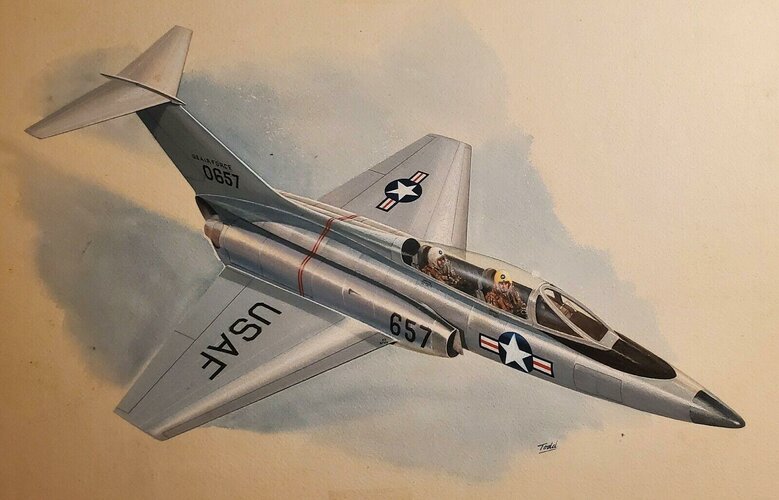 1_00854b162d1e9fd45d9cb310e9e9e43a.jpg189.7 KB · Views: 207
1_00854b162d1e9fd45d9cb310e9e9e43a.jpg189.7 KB · Views: 207 -
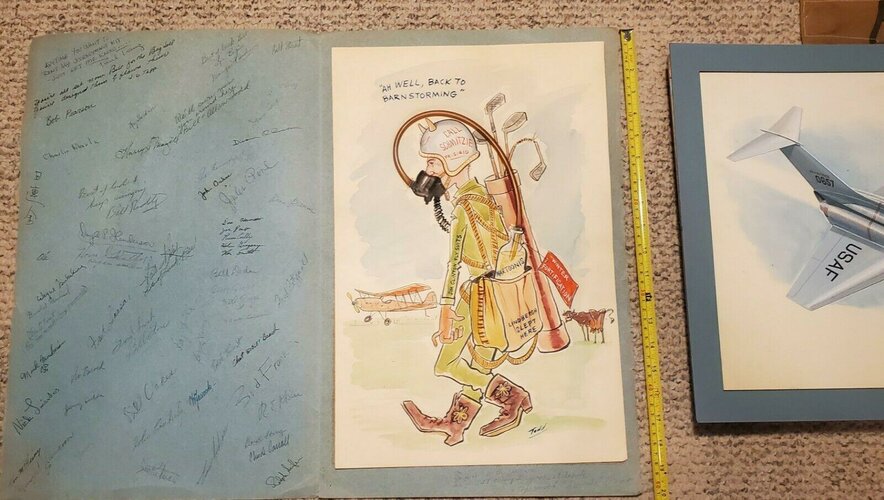 1_00854b162d1e9fd45d9cb310e9e9e43a (1).jpg192.9 KB · Views: 177
1_00854b162d1e9fd45d9cb310e9e9e43a (1).jpg192.9 KB · Views: 177 -
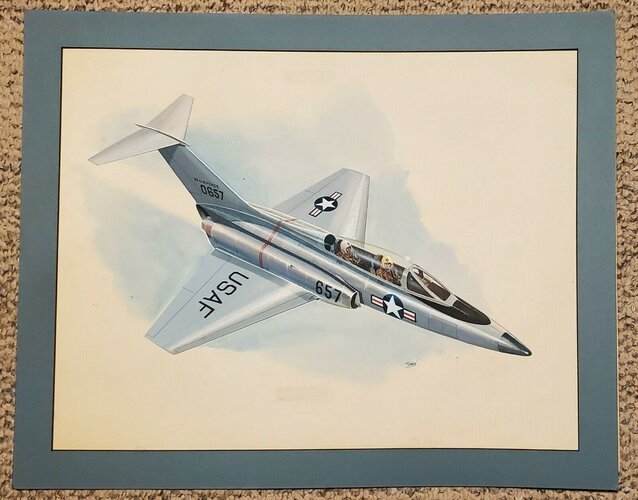 1_00854b162d1e9fd45d9cb310e9e9e43a (2).jpg206.2 KB · Views: 152
1_00854b162d1e9fd45d9cb310e9e9e43a (2).jpg206.2 KB · Views: 152 -
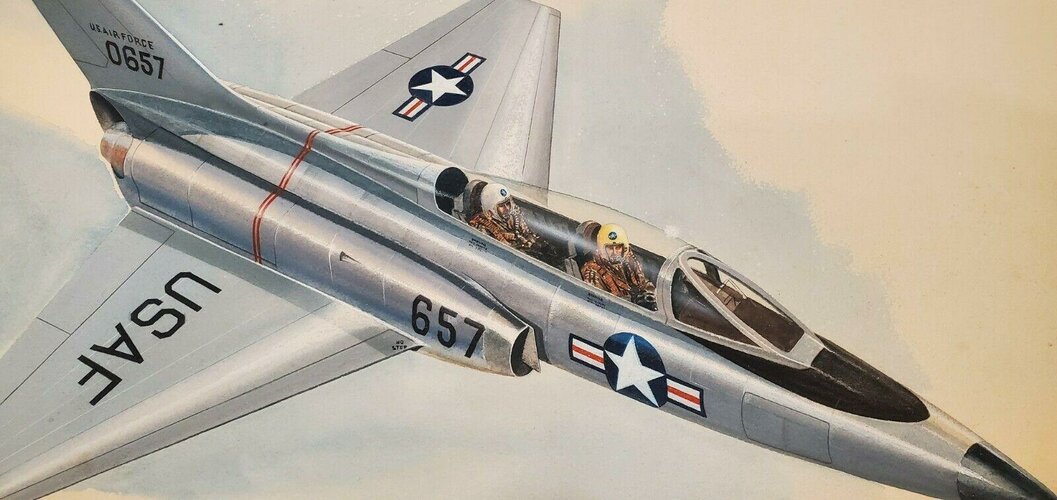 1_00854b162d1e9fd45d9cb310e9e9e43a (3).jpg155.2 KB · Views: 135
1_00854b162d1e9fd45d9cb310e9e9e43a (3).jpg155.2 KB · Views: 135 -
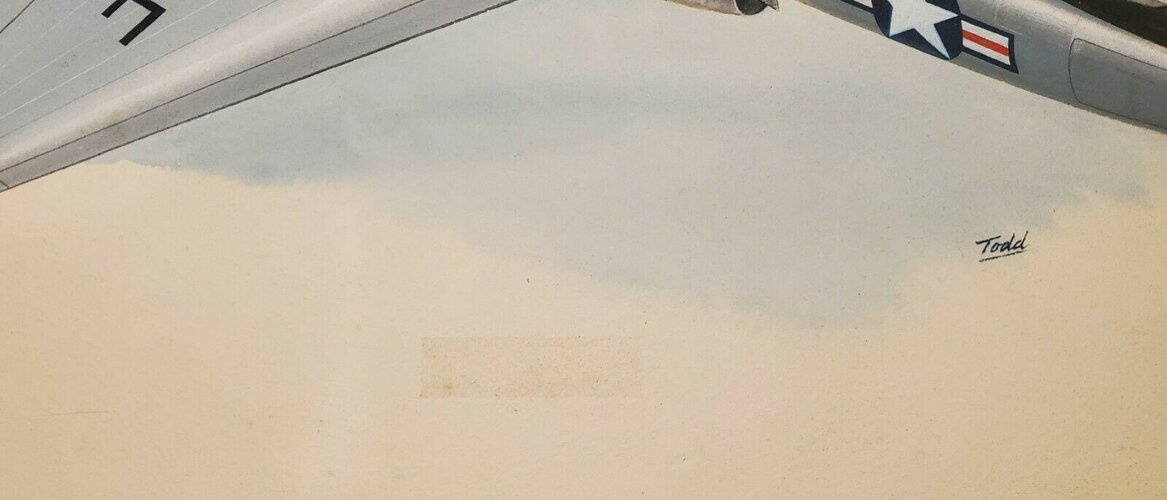 1_00854b162d1e9fd45d9cb310e9e9e43a (4).jpg65 KB · Views: 124
1_00854b162d1e9fd45d9cb310e9e9e43a (4).jpg65 KB · Views: 124 -
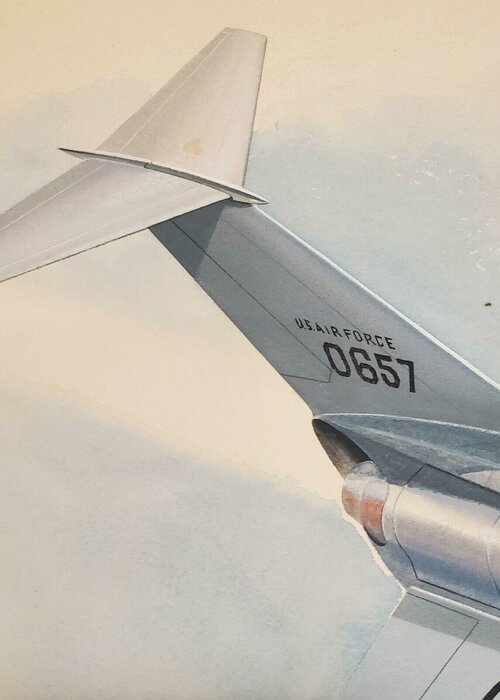 1_00854b162d1e9fd45d9cb310e9e9e43a (5).jpg130.6 KB · Views: 117
1_00854b162d1e9fd45d9cb310e9e9e43a (5).jpg130.6 KB · Views: 117 -
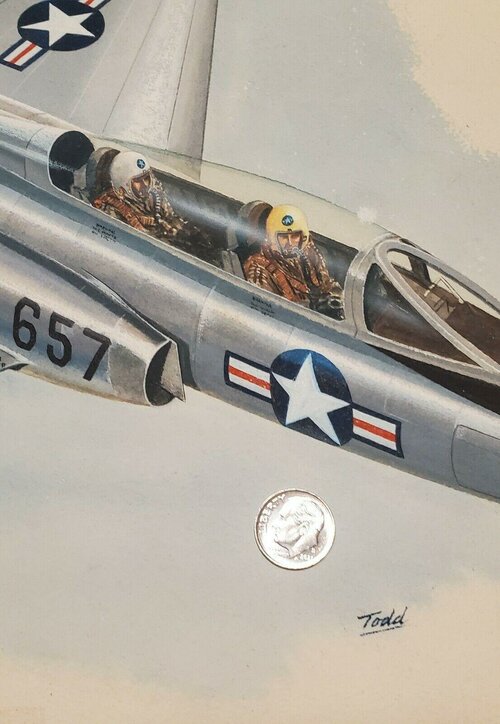 1_00854b162d1e9fd45d9cb310e9e9e43a (6).jpg192.9 KB · Views: 111
1_00854b162d1e9fd45d9cb310e9e9e43a (6).jpg192.9 KB · Views: 111 -
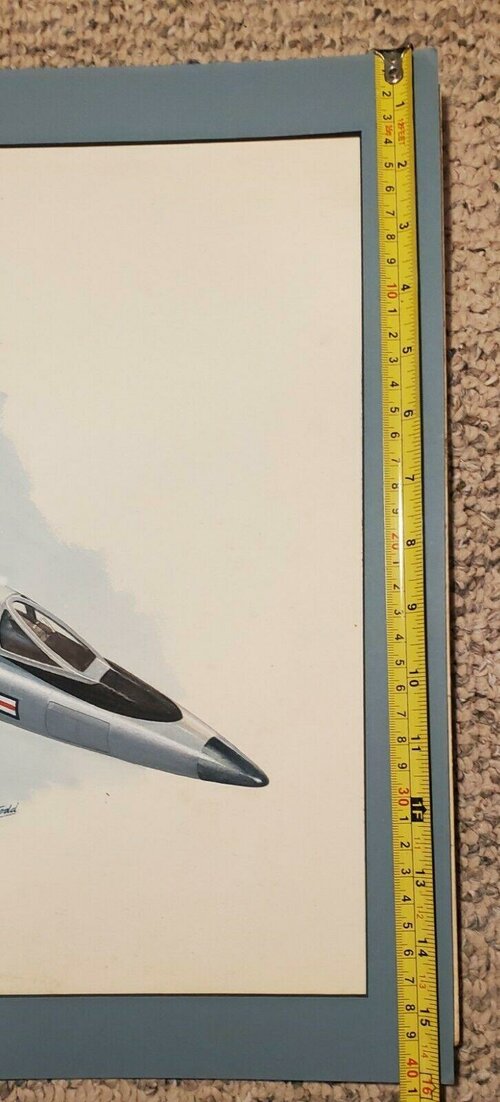 1_00854b162d1e9fd45d9cb310e9e9e43a (7).jpg111.5 KB · Views: 108
1_00854b162d1e9fd45d9cb310e9e9e43a (7).jpg111.5 KB · Views: 108 -
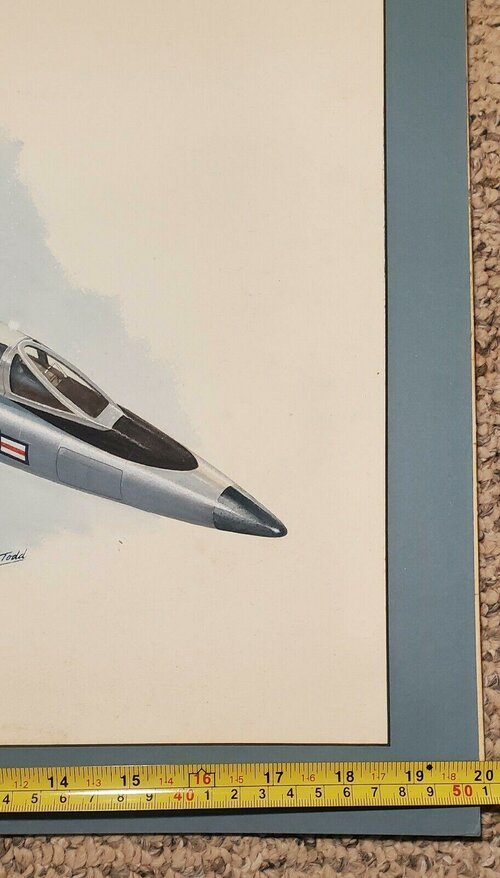 1_00854b162d1e9fd45d9cb310e9e9e43a (8).jpg136.1 KB · Views: 152
1_00854b162d1e9fd45d9cb310e9e9e43a (8).jpg136.1 KB · Views: 152
F.L.
ACCESS: Top Secret
BLACK_MAMBA
ACCESS: Secret
- Joined
- 17 July 2019
- Messages
- 382
- Reaction score
- 877
Already shared in another thread on this website. F-5 developments and derivatives.Model of Super Tiger :
Similar threads
-
-
-
-
-
Lockheed CL-1200 / X-27 Lancer
- Started by overscan (PaulMM)
- Replies: 84

